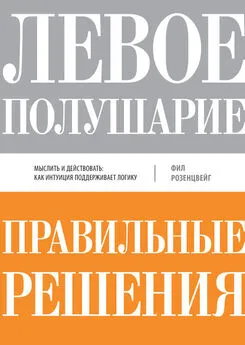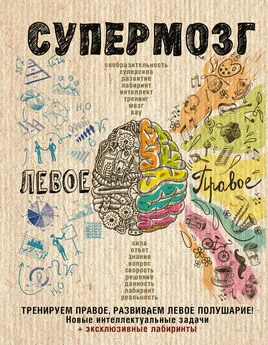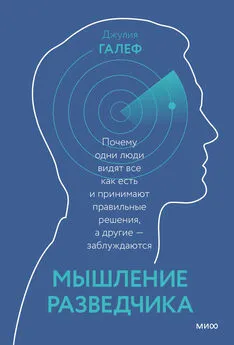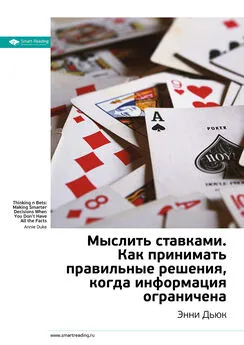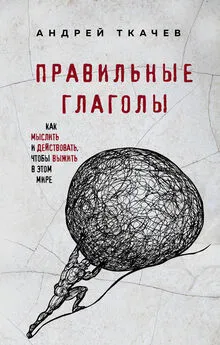Фил Розенцвейг - Левое полушарие – правильные решения. Мыслить и действовать: как интуиция поддерживает логику
- Название:Левое полушарие – правильные решения. Мыслить и действовать: как интуиция поддерживает логику
- Автор:
- Жанр:
- Издательство:Азбука Бизнес, Азбука-Аттикус
- Год:2015
- Город:Москва
- ISBN:978-5-389-09694-3
- Рейтинг:
- Избранное:Добавить в избранное
-
Отзывы:
-
Ваша оценка:
Фил Розенцвейг - Левое полушарие – правильные решения. Мыслить и действовать: как интуиция поддерживает логику краткое содержание
Левое полушарие – правильные решения. Мыслить и действовать: как интуиция поддерживает логику - читать онлайн бесплатно полную версию (весь текст целиком)
Интервал:
Закладка:
Marks, Howard. The Most Important Thing: Uncommon Sense for the Thoughtful Investor. New York: Columbia University Press, 2011.
Mauboussin, Michael J. More Than You Know: Finding Financial Wisdom in Unconventional Places. Boston: Harvard Business School Press, 2007.
Think Twice: Harnessing the Power of Counterintuition. Boston: Harvard Business Press, 2009.
McClement, Mike. Brilliant Confidence: What Confident People Know, Say and Do. Harlow, UK: Pearson Education, 2010.
McGee, Paul. Self-Confidence: The Remarkable Truth of Why a Small Change Can Make a Big Difference. 2nd ed. Chichester, UK: Capstone Publishing Ltd., 2012.
McGrayne, Sharon Bertsch. The Theory That Would not Die: How Bayes’ Rule Cracked the Enigma Code, Hunted Down Russian Submarines, and Emerged Triumphant from Two Centuries of Controversy. New Haven, CT: Yale University Press, 2011.
McKenna, Paul. Instant Confidence: The Power to Go for Anything You Want. London: Transworld Publishers, 2006.
Moltz, Barry J. You Need to Be a Little Crazy: The Truth About Starting and Growing Your Business. Chicago: Dearborn Trade Publishing, 2003.
Morgan, Joe, and David Falkner. Joe Morgan: A Life in Baseball. New York: W. W. Norton&Co., 1993.
Newman, Thomas B., and Michael A. Kohn. Evidence-Based Diagnosis. New York: Cambridge University Press, 2009.
Nye, Joseph S., Jr. The Powers to Lead. Oxford: Oxford University Press, 2008.
Orwell, George. A Collection of Essays. San Diego, CA: Harvest, 1981.
Peters, Thomas J., and Robert H. Waterman Jr. In Search of Excellence: Lessons from America’s Best Managed Companies. New York: Warner Books, 1982.
Plous, Scott. The Psychology of Judgment and Decision Making. New York: McGraw-Hill, 1993.
Raynor, Michael E. The Strategy Paradox: Why Committing to Success Leads to Failure (and What to Do About It). New York: Currency Doubleday, 2007.
Rotella, Dr. Bob. Golf Is a Game of Confidence. New York: Simon&Schuster, 1996.
Seligman, Martin E. P. Learned Optimism: How to Change Your Mind and Your Life. New York: Vintage Books, 2006.
Shapira, Zur. Risk Taking: A Managerial Perspective. New York: Russell Sage Foundation, 1995.
Sharot, Tali. The Optimism Bias: A Tour of the Irrationally Positive Brain.
Shaw, George Bernard. “Maxims for Revolutionists.” In Man and Superman: A Comedy and Philosophy. London: Penguin Books, 2000.
Shenk, David. The Genius in All of Us: Why Everything You’ve Been Told About Genetics, Talent, and IQ Is Wrong. New York: Anchor, 2011.
Silver, Nate. The Signal and the Noise: Why So Many Predictions Fail – But Some Don’t. New York: Penguin, 2012.
Smith, Adam. The Money Game. New York: Vintage Books, 1976.
Sokolove, Michael. Hustle: The Myth, Life, and Lies of Pete Rose. New York: Simon&Schuster, 1990.
Stever, H. Guyford, and James J. Haggerty. Flight. New York: Time Inc., 1965.
Sutton, Robert I. Weird Ideas That Work: 11 1/2 Ways to Promote, Manage, and Sustain Innovation. New York: Penguin, 2001.
Syed, Matthew. Bounce: The Myth of Talent and the Power of Practice: Beckham, Serena, Mozart, and the Science of Success. New York: Harper, 2011.
Taleb, Nassim Nicholas. The Black Swan: The Impact of the Highly Improbable. New York: Random House, 2007.
Tetlock, Philip E. Expert Political Judgment: How Good Is It? How Can We Know? Princeton, NJ: Princeton University Press, 2005.
Thaler, Richard H., The Winner’s Curse: Paradoxes and Anomalies of Economic Life. Princeton, NJ: Princeton University Press, 1992.
Thaler, Richard H., and Cass Sunstein. Nudge: Improving Decisions about Health, Wealth, and Happiness. New Haven, CT: Yale University Press, 2008.
Trilling, Lionel. Sincerity and Authenticity. Cambridge, MA: Harvard University Press, 1971.
Whitacre, Ed, with Leslie Cauley. American Turnaround: Reinventing AT&T and GM and the Way We Do Business in the USA. New York: Business Plus, 2013.
Wolfe, Tom. The Right Stuff. New York: Farrar, Straus, and Giroux, 1979.
Yeager, Chuck, Bob Cardenas, Bob Hoover, Jack Russell, and James Young. The Quest for Mach One: A First-Person Account of Breaking the Sound Barrier. New York: Penguin, 1997.
Yeager, Chuck, and Leo Janos. Yeager: An Autobiography. New York: Bantam Books, 1985.
Yeung, Dr. Rob. Confidence: The Power to Take Control and Live the Life You Want. Harlow, UK: Pearson Education Ltd., 2011.
Zweig, Jason. Your Money and Your Brain: How the New Science of Neuroeconomics Can Help Make You Rich. New York: Simon&Schuster, 2007.
Статьи
Adams, Tim. “How a Book about Baseball Statistics Changed the Way We Think about Football.” Esquire , September 2011, 198–203.
Ahmed, Murad. “Jobs: The Special One.” The Times , October 29, 2011, 16.
Alpert, Marc, and Howard Raiffa. “A Progress Report on the Training of Probability Assessors.” Unpublished manuscript, 1969. In Judgment Under Uncertainty: Heuristics and Biases, edited by Daniel Kahneman, Paul Slovic, and Amos Tversky. Cambridge, UK: CambridgeUniversity Press, 1982.
Ashenfelter, Orley. “Predicting the Quality and Prices of Bordeaux Wine.” Economic Journal 118, no. 529 (June 2008): F174–F184.
AT&T Wireless Services, Inc. Proxy Statement Pursuant to Section 14 (a) of the Securities Exchange Act of 1934, March 22, 2004.
Austen, Ian. “Bicycle Thieves: World-Class Cycling’s Drug Trade.” New York Times , September 12, 2012, C7.
Austin, Michael. “Building the Perfect Arc: Research Shows Players Need to Keep Shot Arc around 45 Degrees.” Winning Hoops , May/June 2010, 20–27.
Baker, Peter, and Jim Rutemberg. “The Long Road to a Clinton Exit.” New York Times , June 8, 2008, A1.
Bazerman, Max H., and William F. Samuelson. “I Won the Auction but I Don’t Want the Prize.” Journal of Conflict Resolution 27 (1983): 618–634.
Bendery, Jennifer. “Nancy Pelosi Predicts 6–3 Supreme Court Vote in Favor of Health Care Law.” Huffington Post , April 4, 2012, http://www.huffingtonpost.com/2012/04/04/nancy-pelosi-health-care-aw_n_1402908.html.
Bennis, Warren. “Acting the Part of a Leader.” Businessweek , September 14, 2009, 80.
Bishop, Greg. “Pacquiao Stunned in Sixth Round.” New York Times , December 9, 2012, http://www.nytimes.com/2012/12/09/sports/juanmanuel-marquez-knocks-out-manny-pacquiao-in-sixth-round.html.
Bornstein, David. “The Dawn of Evidence-Based Budget.” New York Times , May 30, 2012, http://opinionator.blogs.nytimes.com/2012/05/30/worthy-of-government-funding-prove-it.
Boyle, Elizabeth, and Zur Shapira. “The Liability of Leading: Battling Aspiration and Survival Goals in Jeopardy’ s Tournament of Champions.” Organization Science 23, no.4, (2012): 1110–1113.
Brooks, David. “The Fatal Conceit.” New York Times , October 26, 2009, A31.
Byers, Dylan. “Dick Morris Fesses Up.” Politico.com , November 13, 2012, http://www.politico.com/blogs/media/2012/11/dick-morris-fesses-up-149453.html.
Cain, Daylian M., and Allan S. Detsky, “Everyone’s a Little Bit Biased (Even Physicians).” JAMA 299, no.24 (June 25, 2008): 2893–2895.
Camerer, Colin, and Dan Lovallo. “Overconfidence and Excess Entry: An Experimental Approach.” American Economic Review 89, no 1 (1999): 306–318.
Campbell, Charles A. “A Decision Theory Model of Entrepreneurial Acts.” Entrepreneurship Theory and Practice 17, no. 1 (1992): 21–27.
Capen, Edward C., Robert V. Clapp, and William M. Campbell. “Competitive Bidding in High Risk Situations.” Journal of Petroleum Technology 23 (1971): 641–653.
Casscells, Ward, Arno Schoenberger, and Thomas Graboys “Interpretation by Physicians of Clinical Laboratory Results.” New England Journal of Medicine 299: 18 (1978) 999–1001.
Cauley, Leslie. “BellSouth Likes to Go It Alone.” USA Today, October 31, 2005, http://usatoday30.usatoday.com/tech/news/techpolicy/business/2005–10–31-bellsouth-mergers_x.htm?POE=TECISVA.
Chakrabortty, Aditya. “Haven’t the Politicians Desperately Scrambling to Form a Government Heard of the Winner’s Curse?” The Guardian , November 5, 2010, 5.
College Board. Student Descriptive Questionnaire. Princeton, NJ: Educational Testing Service, 1976–1977.
Corporate Finance Advisory and Mergers&Acquisitions. “Uncorking M&A: The 2013 Vintage.” J. P. Morgan , December 2012.
Craggs, Tommy. “Say-It-Ain’t-So Joe.” SF Weekly , July 6, 2005, http://www.sfweekly.com/2005–07–06/news/say-it-ain-t-so-joe.
Critchley, Simon, and Jamieson Webster. “The Gospel According to ‘Me’.” New York Times , June 30, 2013, SR8.
DeBondt, Walter F., and Richard H. Thaler. “Financial Decision-Making in Markets and Firms: A Behavioral Perspective.” Handbooks in OR&MS 9 (1995): 385–410.
Dew, Nicholas, Saras Sarasvathy, Stuart Read, and Robert Wiltbank. “Affordable Loss: Behavioral Aspects of the Plunge Decision.” Strategic Entrepreneurship Journal 3 (2009): 105–126.
Diaz, Jaime. “Perils of Putting: Duffers, Take Heart. A New Study by the PGA Tour Reveals That When It Comes to Putting, the Pros Aren’t So Hot Either.” Sports Illustrated , April 3, 1989.
Dosi, Giovanni, and Dan Lovallo, “Rational Entrepreneurs or Optimistic Martyrs? Some Considerations on Technological Regimes, Corporate Entries, and the Evolutional Role of Decision Biases.” In Technological Innovation: Oversights and Foresights, edited by Raghu Garud, Praveen Nattar Nayyar, and Zur Baruch Shapira, 41–68. New York: Cambridge Innovation: Oversights and Foresights, edited by Raghu Garud, Praveen Nattar Nayyar, and Zur Baruch Shapira, 41–68. New York: Cambridge University Press, 1997.
Dubner, Stephen J., and Steven D. Levitt. “A Star Is Made.” New York Times , May 7, 2006, http://www.nytimes.com/2006/05/07/magazine/07wwln_freak.html?pagewanted=all.
Dunne, Timothy, Mark J. Roberts, and Larry Samuelson. “Patterns of Firm Entry and Exit U. S. Manufacturing Industries.” Rand Journal of Economics 19, no. 4 (Winter 1988): 233–271.
Eckhardt, Roger. “Stan Ulam, John von Neumann, and the Monte Carlo Method.” Los Alamos Science 15, Special Issue (1987): 131–137.
Eichler, Jeremy. “String Theorist: Christian Tetzlaff Rethinks How a Violin Should Sound.” New Yorker, August 27, 2012, 34–39.
Ericsson, K. Anders, Ralf Th. Krampe, and Clemens Tesch-Rцmer. “The Role of Deliberate Practice in the Acquisition of Expert Performance.” Psychological Review 100, no. 3 (1993): 363–406.
Ericsson, K. Anders, Michael J. Prietula, and Edward T. Cokely, “The Making of an Expert,” Harvard Business Review , July—August 2007, 114–121.
Feynman, Richard P. “What Is and What Should Be the Role of Scientific Culture in Modern Society.” Address to the Galileo Symposium, Italy, 1964. In The Pleasure of Findings Things Out: The Best Short Works of Richard P. Feynman , 106–107. London: Penguin, 1999.
Fienberg, Stephen E. “When Did Bayesian Inference Become Bayesian?” Bayesian Analysis 1, no. 1 (2006): 1–40.Fisher, Kenneth L. “The Eight Biggest Mistakes Investors Make.” UT Today 1 (2007): 50–53.
Читать дальшеИнтервал:
Закладка:
